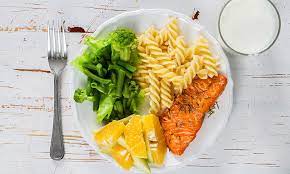Healthy eating is the foundation of a healthy lifestyle.
These Guidelines will help you to create a healthy diet. You can use them to create your food plan. These basic tips and a summary of the Australian Dietary Guidelines will help you get started.
- You can choose from a variety of cuisines. Five food groups :
- Many colorful vegetables and legumes/beans
- fruit
- Cereal grains (grain) – mainly whole grain and high fiber varieties
- lean meats, poultry and fish, eggs, tofu and nuts
- Milk, yogurt and cheese, or alternatives are mostly low in fat. Reduced-fat bowls of milk are not recommended for children younger than two years.
- Get plenty of water.
- Limit foods high in saturated fat such as cookies, pastries and cakes, processed meats, burgers, pizzas, fried foods, potato chips and crisps.
- High-fat foods high in saturated fat should be replaced with low-fat foods containing mostly monounsaturated or polyunsaturated fats. Replace butter, cream, butter, coconut oil, cooking margarine, palm oil, and other saturated fats with unsaturated fats obtained from oils, spreads and pastes as well as avocado.
- Limit salty foods and beverages, and avoid salty foods at the table or cooking.
- Limit the consumption of added sugars in foods and beverages, including confectionery, sugar-sweetened soft drinks and cordials and fruit drinks, energy drinks, and vitamin waters.
- Limit alcohol. To reduce your chance of alcohol-related injury or disease, you should limit your intake to two standard drinks per day. You should also limit your consumption of standard drinks at all times. It is safer not to drink alcohol if you are pregnant, planning to get pregnant, or breastfeeding.
Along with the healthy eating guidelines, you should aim to do at least 30 minutes of moderate-intensity physical activity every day, such as walking.
Fruits and vegetables (and legumes).
All fruits, vegetables, and legumes provide vitamins, minerals and dietary fiber, and nutrients. Many are low in calories, making you feel fuller for longer.
Legumes also contain protein to be used as a substitute for meat. Split peas can be made from kidney beans, soybeans (navy beans), chickpeas, and lentils.
Your body will benefit from eating many different foods from this food group. It may also help prevent certain chronic diseases like stroke, heart disease, diabetes, and other cancers.
This guide will help you to determine your daily needs.
Vegetables How much should you eat each day?
- Younger children: 2.5 serves for 2-5-year-olds, 4.5 serves 4-8 year-olds
- Older children – 5 to 5.5 serves for older kids and adolescents.
- Adults and pregnant women – 5-6 servings
- Breastfeeding mums – 7+ meals
- A standard serve is approximately 75g (100-350 Kilojoules); 1/2 cup of green or orange vegetables (broccoli or carrots), or 1 cup green leafy, raw or mixed salad vegetables.
Fruit How much should you eat each day:
- Younger children: 1 serving for 2-5-year-olds, 1.5 for 4-8 years olds
- Adults, older children and adolescents, and pregnant and nursing women should have two meals.
150g (350 kilojoules) is the standard serving size. This could include a medium or large apple, banana, or two plums or kiwifruits. Consume whole fruits and not juice.
Legumes/beans (as a source of protein – how much you should eat each day:
- *Children – 1 to 2.5 servings, depending upon age *Men – 2.5 to 3.0 serves, depending on their age
- *Women: 2 to 2.5 servings, depending on their age
- *Pregnant women – 3.5 Serves
- *Breastfeeding women: 2.5 servings
A standard serving is between 500 and 600 kilojoules. For example, 1 cup of split peas, canned or cooked chickpeas, split peas or lentils or 170g of tofu.
Grains
Wholemeal and wholegrain foods are healthier than refined grains (cereals) because they have more nutrients, vitamins, and fiber. Whole grains can help prevent heart disease, type 2 diabetes and excessive weight gain.
Cereal grains with high levels of saturated fats added sugars, and salt is considered ‘extras’ or “sometimes foods” in this food group.
Grain food: How much should you put on your plate every day?
- younger children – 4 serves
- Older children and adolescents – 7 Serves
- Women – 3 serves are for those over 70 years; 6 serves are for those under 50 years; 8.5 serves for pregnant or breastfeeding women.
- Men – 4.5 for men over 70 years old; 6 for younger men.
Five hundred kilojoules are the standard serving size. This could be one slice of bread or half a cup of porridge. Wholegrain varieties should make up at least two-thirds.
Lean meats, poultry and fish, eggs, fish, tofu, nuts, seeds, legumes/beans
All protein sources are plentiful, including lean meats, poultry and fish, eggs, legumes/beans, tofu and nuts. A variety of these foods will give you the protein you need along with a range of other nutrients such as iron, zinc and vitamins (especially B12), as well as vitamins and essential fatty acids.
According to the Australian Dietary Guidelines, you should eat at least one serving of each food group per day. Three to four servings per day are recommended for pregnant women.
How much should you eat each day?
- Children – 1 to 2.5 servings, depending on their age
- Men: 2.5 to 3 servings, depending on their age
- Women: 2 to 2.5 servings, depending on their age
- Pregnant women: 3.5 servings
- Breastfeeding women: 2.5 servings
A standard serving is between 500 and 600 kilojoules. For example, 80g of cooked lean poultry (100g raw), 100g of cooked fish fillets (about 115g raw), 65g of cooked lean meat (about 90-100 graw), two large eggs (60g each), 170g tofu, 30g nuts or seeds or 150g cooked legumes.
Dairy
Milk and yogurt are rich in calcium, other minerals, protein and vitamins. They are good for heart health and can reduce the likelihood of stroke and high blood pressure. Dairy is good for bone health.
Select varieties that are low in added sugar and saturated fat.
You can avoid dairy by choosing calcium-enriched soy or rice drinks. You should ensure that they contain at most 100 mg of calcium per 100 ml.
How much milk, yogurt, cheese or others should you put on your daily plate?
- Children: 1.5 to 3.5 servings, depending on their age
- Men: 2.5 to 3.5 servings, depending on their age
- Women: 2.5 to 4 servings, depending on their age
- Pregnant women: 2.5 servings
- Breastfeeding women: 2.5 servings
A standard serving is between 500 and 600 kilojoules. This could be a cup of milk or 3/4 cup of yogurt.
“Extras” or “Sometimes foods”
Because some foods are not healthy, they are called ‘discretionary food’, sometimes food’ or an ‘extra’. Extras include added sugar, saturated fat, salt and kilojoules. These include commercial burgers, pizzas, alcohol, lollies and cakes, and fruit juices and cordials. You can find more information at Food to eat sometimes.
Learn more about how much to eat
Eat for Health has information about exact servings as well as other examples.
Timer for your food intake
Healthy eating habits start with what you eat. Eat breakfast is the best food timing tip. Breakfast means “to break the fast” from the last meal of the night to the first meal of the day.
People who skip breakfast are more likely not to eat healthy choices later in the morning and to consume larger portions at their next meal. Children who skip breakfast have lower nutrition and perform worse at school.
These are other food timing tips:
- Regular eating: Consistency is key to consuming all five food groups. It would be best to eat breakfast, lunch, dinner, and two snacks.
- Listen to your body: Eat when you feel hungry, and stop eating when you feel full.
- Take your time while you eat. Turn off the TV and computer. Please pay attention to your body and the signals it sends.
- Don’t eat dinner at night. This allows your body to process and utilize the Food. If you are looking for a late-night snack, a glass of milk or a cup of decaffeinated tea or herbal tea might be a good option.
- Eat more at lunch than at dinner. The body is most efficient at digesting peak energy times between noon and 3 pm. Splitting a larger lunch into smaller meals can help you manage it. You can eat one meal at noon and one mid-afternoon. Eating dinner an hour earlier also aids evening digestion.
- Take 45 minutes to digest. This will decrease the amount of energy stored as fat since the body will replenish low glycogen reserves.
Carbohydrates, glycaemic index
Carbohydrates are your body’s primary energy source. You can find them in loaves of bread, cereals, pasta, potatoes, starchy vegetables, corn and dried beans. They also come in milk, yogurt, and milk. A carbohydrate at every meal is good for fueling the body throughout the day.
In your healthy diet, include a variety of good-quality carbs such as rice, bread, pasta, quinoa (preferably whole grains or high fiber varieties), and legumes.
Carbohydrate-containing foods are rated on the glycaemic index (GI) scale. This rating, which can range from zero to 100, is related to the speed at which the carbohydrate is absorbed into the bloodstream and how it affects blood glucose levels.
Low-GI foods (GI below 55) are slow to absorb and provide sustained energy throughout the day. Wholegrain bread, pasta and wholegrain bread are all examples.
High GI foods (55 and more on the GI Scale) are rapidly digested and absorbed into your bloodstream. White and wholemeal loaves of bread, processed cereals, short grains, rice, potatoes, crackers and watermelon are examples of high GI foods.
You can eat high- and low-GI foods. However, it is recommended to eat more Food at the lower end of the GI scale to improve your Health.
Remember…
- The Australian Dietary Guidelines can be used as a foundation to create a healthy diet that meets your needs. If you have questions about nutrition or specific nutritional needs, consult an Accredited Practising Dentist.
- You can eat a variety of foods from all five food groups. Limit saturated fat, added salt, added sweetness, and alcohol.
- You should know how much you can put on your plate.
- Water is your primary drink.






More Stories
Chocolate self saucing pudding
Chicken patties recipe
Can you eat a raw potato